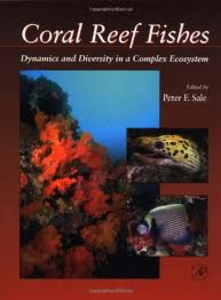Ecomorphology of feeding in coral reef fishes
Wainwright, Peter C., and Bellwood, David R. (2002) Ecomorphology of feeding in coral reef fishes. In: Sale, Peter S., (ed.) Coral Reef Fishes: dynamic and diversity in a complex ecosystem. Elsevier, San Diego, CA, USA, pp. 33-55.
|
PDF (Published Version)
- Published Version
Restricted to Repository staff only |
||
![[img]](https://researchonline.jcu.edu.au/14369/2.hassmallThumbnailVersion/14366-14369%2C_743%2C_4392_coral_reef_fishes.jpg)
|
Image (JPEG) (Front Cover)
- Cover Image
Download (8kB) |
Abstract
[Extract] O nce an observer gets past the stunning coloration, surely no feature inspires wonder in coral reef fishes so much as their morphological diversity. From large-mouthed groupers, to beaked parrotfish, barbeled goatfish, long-snouted trumpet fish, snaggle-toothed tusk fish, tube-mouthed planktivores, and fat-lipped sweet lips, coral reef fishes display a dazzling array of feeding structures. And, even the most casual fish watcher quickly gets a sense that this diversity means something, that fish form is related to what the animals eat. Clearly there is something to this impression, but just how are head and body morphology connected to prey choice? Are we really able to predict what a reef fish eats from studying its jaws and teeth? What are the major axes of diversification that are seen in reef fishes? Which morphological and ecological trophic types show the most common convergence? What ecological insights into reef processes have been gained from consideration of the functional design of fish feeding mechanisms?
In this chapter we explore the relationship between fish anatomy and feeding habits. Our overall goal is to show how an understanding of the functional morphology of fish feeding mechanisms can be a powerful tool when considering several ecological issues in coral reef fish biology. We have attempted to identify generalities, the major patterns that seem to cut across phylogenetic and geographic boundaries. We begin by constructing a rationale for how functional morphology can be used to enhance our insight into some long-standing ecological questions. We then review the fundamental mechanical issues associated with feeding in fishes, and the basic design features of the head that are involved in prey capture and prey processing. This sets the stage for a discussion of how the mechanical properties of fish feeding systems have been modified during reef fish diversification. With this background, we consider some of the major conclusions that have been drawn from studies of reef fish feeding ecomorphology. Because of space constraints we discuss only briefly the role of sensory modalities--vision, olfaction, electroreception, and hearingmbut these are also significant and diverse elements of the feeding arsenal of coral reef fishes and entire review chapters could be written on each one.
| Item ID: | 14369 |
|---|---|
| Item Type: | Book Chapter (Research - B1) |
| ISBN: | 978-0-12-615185-5 |
| Related URLs: | |
| Date Deposited: | 07 Dec 2010 05:36 |
| FoR Codes: | 06 BIOLOGICAL SCIENCES > 0603 Evolutionary Biology > 060399 Evolutionary Biology not elsewhere classified @ 100% |
| SEO Codes: | 97 EXPANDING KNOWLEDGE > 970106 Expanding Knowledge in the Biological Sciences @ 100% |
| Downloads: |
Total: 286 Last 12 Months: 3 |
| More Statistics |



